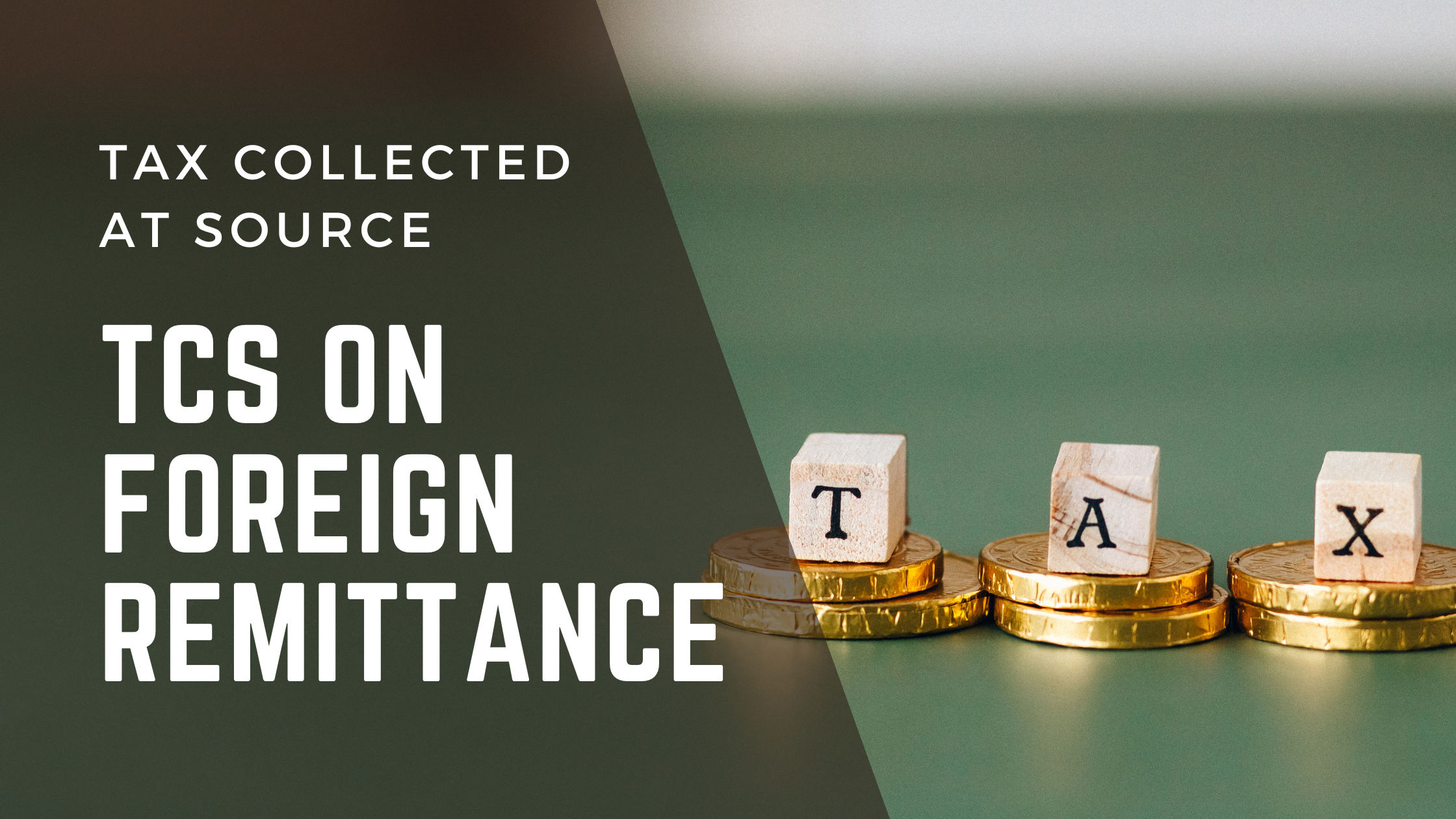
TCS on Foreign Remittance: All You Need to Know About It
Understanding the impact of TCS on foreign remittances under LRS and strategies to navigate the new 20% rule
In this globalised and interconnected economy, international travel and global transactions have become increasingly common. With the migration of people across the globe for business, studies, lifestyle, culture, and career, people are leaning on convenient, secure, and quick money transfer solutions. But did you know, a charge called TCS is applied in India while international money transfer is done?
If you don’t know, then don’t worry, this blog will talk about everything there is to know about TCS on foreign remittance, especially under the purview of new updates. Let’s begin by understanding what TCS on foreign remittance means.
What is TCS on Foreign Remittance?
Tax at source or TCS refers to the tax levied by the Indian government on money sent abroad (i.e., remittance). This tax is applicable under the Liberal Remittance Scheme (LRS). Under the LRS, residents can remit up to USD 250,000 for various purposes including, education, travel, gifts, or currency exchange.
Although TCS may be perceived as an additional tax burden at the first glance. However, it is an advanced tax payment which can be adjusted against the overall tax liability while filing income tax returns.
What’s New About TCS: The Union Budget Update in 2023
Under the Union Budget of 2023, the TCS received a crucial update. The tax levied on TCS has been increased to 20% from 5%. This revised rate has been applicable from October 1st, 2023.
Earlier, the TCS never had a fixed rate, but different rates were applicable based on the purpose of remittance. But with this new update, the rates are more uniform.
Although, for education and medical expenses, the point to note here is that, the rate of TCS remains the same (i.e., at 5%). Therefore, individuals involved in remittances, travel, or other personal purposes need to be cautious and consider the new rate (20%) into account.
Understanding The application of TCS: Tax Collected at Source
The underlying principle behind the TCS on foreign remittance is that an advanced tax is collected for tracking high-value transactions with ease. This means, the tax money is deducted before sending money abroad at the source.
This is how TCS on foreign remittance is applied under the LRS:
- Who Collects TCS: Your authorised dealer (bank or financial institution) collects the tax
- When is TCS Collected: At the source, i.e., when the money is remitted abroad
- On Which Amount: Under the LRS, TCS is applied on the total remitted amount that exceeds the ₹7 lakh limit for a financial year
Example:
Suppose you are sending ₹10 lakh to the United States to cover for a personal expense or travel. As per the revised TCS rates under LRS, 20% of tax will be collected as TCS (as the amount has exceeded the ₹7 lakh limit). In this case, ₹60,000 will be deducted as TCS.
The Reason: Why The TCS on Foreign Remittance Was Increased to 20%?
One of the core reasons for increasing the TCS on foreign remittance to 20% is to enhance tax compliance by the government. This step was also taken in the light of the fact that foreign transactions made by several companies or individuals were not reflected in the tax returns.
Therefore, the government decided to increase the TCS rate with an aim to:
- Track high-value transactions easily
- Enhance the tax compliance among such industries or individuals engaging in large international money transfers or investments
In 2022, the outward remittance spiked at a time the Indian Rupee has weakened. Therefore, with the TCS on outward remittance, the government wants to encourage the citizens to spend money within India. Also, this way those who are spending money abroad can file returns in India, aiding the revenue collection by the government.
The Impact of TCS: How Is The New TCS Hike Affecting You?
If you are a student or covering for medical expenses, then nothing much has changed for you with the revised TCS rates. However, if you are a business owner, trader, or investor, then you have to be mindful about the international transactions you carry out.
The TCS on foreign remittance impacts anyone involved in foreign transactions beyond the exemption limit, i.e., ₹7 lakh. Here are some common scenarios for your reference:
- Travel: If you are planning your next vacation aboard, then be caution about TCS while booking hotels or flights
- Education: Although the TCS rate for education is at 5%, you still need to plan larger funds transfers carefully.
- Investment: If you are investing in foreign assets, including stocks or property, this 20% hike will significantly impact your cash flow.
Pro Tip:
With an expert Forex Service provider, like Laxmii Forex, you can plan your international money transfers carefully. We even offer free consultation on TCS guidelines and Forex services
Rate Comparisons:
Here’s a table offering comparison of the old and new TCS rates:
| Purpose of Remittance | Revised TCS Rate | Previous TCS Rate |
|---|---|---|
| Money transferred for education purposes Source: Educational loan | 0.5% of the amount if exceeding the ₹7 lakh limit. Zero if lesser than ₹7 lakh | 0.5% of the amount if exceeding the ₹7 lakh limit. Zero if lesser than ₹7 lakh |
| Money transferred for education purposes or medical expenses Source: Any other source than educational load | 5% of the amount if exceeding the ₹7 lakh limit. Zero if lesser than ₹7 lakh | 5% of the amount if exceeding the ₹7 lakh limit. Zero if lesser than ₹7 lakh |
| Other purposes | Zero up to ₹7 lakh and 20% or above if it amounts to more than ₹7 lakh | Zero up to ₹7 lakh and 5% if it amounts to more than ₹7 lakh |
How to Manage TCS Under LRS Efficiently?
Does the revision of the TCS on foreign remittance feel heavy? Don’t worry, there’s an option to claim it while filing your tax returns. Here’s how:
As TCS is an advance tax, it can be deducted from your total tax liability at the end of the financial year
You can claim a refund if your total income is below the taxable limit or your tax liability is lower than the collected amount.
You can make the refund process or tax credit easier if all your foreign remittance transactions are reported properly in Form 26AS.
Strategies to Minimise TCS Liability
Although TCS on remittance cannot be avoided, there are ways to minimise its impact.
Plan: Strategically plan large funds. Consider splitting the large remittances across the fiscal yeast to reduce the burden of TCS
Exempt Categories: Use the exceptions categories for attracting lower TCS rates
Tax Deductions: You can use the TCS collected as a credit against your total payable tax to reduce the overall liability
Seek Guidance: Get advice from experts like Laxmii Forex for economical payment solutions including flywire remittance invoices or Forex cards.
How Can Laxmii Forex Help With International Money Transfer?
With the changing TCS rules and rates, it can be a little difficult to plan your international money transfers. If you rely on Laxmii Forex, you can streamline your foreign remittance seamlessly.
Here’s how we can help with your international money transfer needs:
- Our Attractive Rates: We offer the lowest possible exchange rates in the market to ensure your international fund transfers is an economical venture
- Our Service: We offer a quick, fast, and highly secure medium to enable your cross-border money transfers.
- Our Options: We have different options to ensure hassle-free funds transfers including, Student Forex cards, flywire payments, GIC, and blocked account payments.
- Our Support: Our customer service team is skilled and ready to address your payment-related concerns.
- Our Speed: We transfer money across borders within one business day, that’s how quick we are.
- Our Credibility: We are RBI authorised AD II Forex company with over 20 years of expertise.
- Our Consultation: We also offer free consultation on TCS and Forex guidelines to help you streamline your fund transfers.
Conclusion:
The revised TCS rates on foreign remittance have introduced significant changes with the 20% hike. However, you can manage your remittance effectively with proper planning and strategy. Staying informed is crucial to ensure proper tax filing and claiming returns. At Laxmii Forex, we ensure your international fund transfers are cost-effective and seamless. Our extensive services also include travel insurance. Consult us today!
FAQs
The new TCS rule on foreign remittance has hiked the rate to 20% from 5% for most foreign remittances (exceeding ₹7 lakh) except for medical and education expenses under the LRS.
The TCS cannot be completely avoided, but its impact can be minimised with the right Forex service partner like Laxmii Forex.
The limit for the TCS is ₹7 lakh. When the remittances exceed ₹7 lakh in a fiscal year, the TCS is applied.
The 5% rule refers to the 5% TCS rate applied on the foreign remittances for education or medical expenses, when the amount exceeds ₹7 lakh.
Individuals who have paid TCS with the tax liability lower than the collected amount or with income lower than the taxable limit are eligible for a TCS refund claim while filing their income tax returns.
TCS is not applicable on international transfers below ₹7 lakh per year for payments associated with medical treatments and education under specific conditions as per the LRS.


Hey people!!!!!
Good mood and good luck to everyone!!!!!
This is pretty informative, couldn’t stop myself from commenting after reading that.
I am really impressed together with your writing abilities as smartly as with the layout to your weblog. Is this a paid subject matter or did you customize it yourself? Anyway keep up the excellent quality writing, it’s rare to look a nice blog like this one these days!